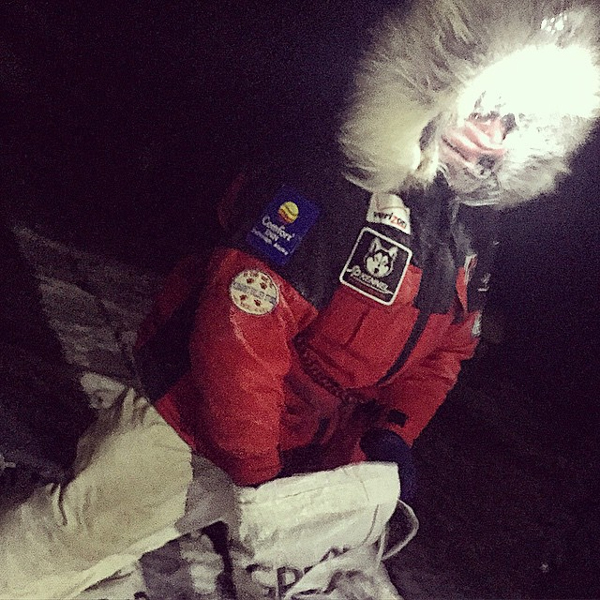
In the final push for Nome, Iditarod mushers are making big moves and cutting rest, but fresh snow, and drifted trail isn’t only slowing the leaders – trail conditions have also slowed dog teams in chase mode.
When Aliy Zirkle pulled her dog team into Koyuk, she was in good spirits, but her dog team was lacking their usually energy.
Zirkle summed up the 50 mile run from Shaktoolik in one word: Slow.
“I didn’t walk, although my dogs did,” Zirkle said. “I jog on the treadmill faster than we were going.”
Overnight, at least four inches of fresh snow fell along the trail to Koyuk. Back in Unalakleet, Zirkle hinted that she planned to make a move. She wanted to blow through Shaktoolik in an attempt to catch Dallas Seavey, but she says the snow slowed her team and ruined her plan.
“This was my – what do you call that when you throw that long pass?” Zirkle said. “This was my Hail Mary and I think they other team caught it and scored a touchdown.”
Zirkle says her team is unlikely to recover.
Schwing: “Are you still in this race?
Zirkle: “Oh no, I’m not in it for first, that’s for sure.”
Schwing: “What are you in it for?”
Zirkle: “I don’t know I’ll get back to you on that too.”
Jessie Royer, arrived roughly a half hour after Zirkle.
“This snow is horrible. I do not like this snow,” Royer said. “It is just – I mean it’s not setting up. The dogs just work so hard and they’re not getting anywhere.”
Royer made a big push to catch the front of the pack, but of the teams running in the top five, hers has rested the least number of hours since Kaltag.
“Oh, I’m a little low on rest, yeah, but they’re doing alright though,” she said. “They’re tired, but they’re not exhausted.”
Royer is also realistic about how the race is likely to play out ahead of her.
“Oh, you know, Dallas is pretty tough,” Royer said. “Something would have to happen to Dallas, because right now if you look at the times Dallas and I are running, he’s running faster than I am and he’s three hours ahead of me and that doesn’t look good unless something happens.”
“Of all people I should know that it’s not over till it’s over, after it went down last year,” Dallas Seavey said.
Last year, Seavey didn’t know he’d won the Iditarod until after he crossed the finish line. A fierce windstorm at the end of the race shook up teams at the front of the pack.
This year, Seavey is running a similar race schedule. He was able to grab four and a half hours of rest in Shaktoolik and run to Koyuk in just over seven hours.
“We got speed, that’s our thing,” Seavey said.
As he cut up frozen food for his dogs with his ax, he said he was well aware of the dramatics moves mushers were making behind him, but he also knows they are cutting rest to keep up.
“You can do runs like that, but then you’re in deep debt to your dog team, you owe them rest,” he said. “So as much as the other teams have been running hard to get here, I’ve been resting hard.”
In his attempt to take that lead, Aaron Burmeister tried to run 90 miles to Koyuk from Unalakleet on minimal rest, but it took his team more than 15-and-a-half hours to break the trail.
“I know he had a much easier run than I did coming over here, because he was following a trail, he didn’t have to tell his leaders ‘gee’ and ‘haw’ every five minutes going through the dark with the only thing you can see for the sign of a trail was a reflector,” he said.
Burmeister says it was a gamble, but he doesn’t regret the move. The trail report calls for more fresh snow and heavy drifting, He says he’s happy to hand over the trail breaking effort to rival Dallas Seavey.
